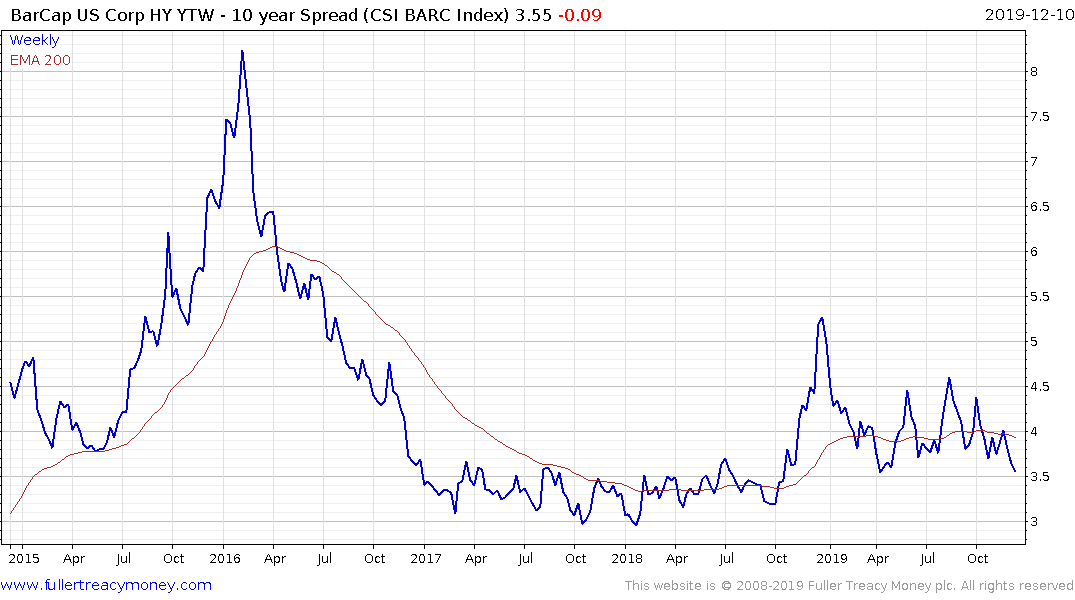Does corporate America have a debt problem?
Thanks to a subscriber for this report by Dan Heron, Ryan Primmer for UBS Asset Management which may be of interest. Here is a section:
Other key measures favored by ratings agencies tell a more pessimistic story for the outlook for US credit in general and for BBB and the likelihood of downgrades in particular. Using US Net Debt/ EBITDA, current US (Exhibits 7, 8 & 9) leverage ratios imply as much as USD 300bn of downgrades from BBB to high yield over the coming year—equivalent to 25% of the US HY market. We believe HY investors would struggle to digest such an increase in supply without material disruption.
But as our UBS Investment Bank colleagues recently pointed out in addressing precisely this issue, on the measure of financial health that has the strongest relationship with ratings downgrades, US non-financial debt ratios are actually healthier than average and significantly lower than during the last two US recessions: “The relationship between debt to enterprise value ratios and IG to HY downgrades is much stronger.” And based on this measure alone, “the read-through for 2019 fallen angel risk would also be of the order of $50–75bn, or only 4% to 6% of the HY bond market.”
On balance this is a mixed picture. While still robust US corporate earnings growth suggests that near-term risks are not significant, we remain wary of rising late cycle tail risks. While it is not our base case, the probability is rising of a vicious cycle of worse-than-expected revenue and EPS growth driving deteriorating debt fundamentals and prompting first investment grade spreads wider ahead of ratings downgrades and then high yield spreads wider too.
Here is a link to the full report and here is a section from it:
Other key measures favored by ratings agencies tell a more pessimistic story for the outlook for US credit in general and for BBB and the likelihood of downgrades in particular. Using US Net Debt/ EBITDA, current US (Exhibits 7, 8 & 9) leverage ratios imply as much as USD 300bn of downgrades from BBB to high yield over the coming year—equivalent to 25% of the US HY market. We believe HY investors would struggle to digest such an increase in supply without material disruption.
But as our UBS Investment Bank colleagues recently pointed out in addressing precisely this issue, on the measure of financial health that has the strongest relationship with ratings downgrades, US non-financial debt ratios are actually healthier than average and significantly lower than during the last two US recessions: “The relationship between debt to enterprise value ratios and IG to HY downgrades is much stronger.” And based on this measure alone, “the read-through for 2019 fallen angel risk would also be of the order of $50–75bn, or only 4% to 6% of the HY bond market.”
On balance this is a mixed picture. While still robust US corporate earnings growth suggests that near-term risks are not significant, we remain wary of rising late cycle tail risks. While it is not our base case, the probability is rising of a vicious cycle of worse-than-expected revenue and EPS growth driving deteriorating debt fundamentals and prompting first investment grade spreads wider ahead of ratings downgrades and then high yield spreads wider too.
Corporations have jumped at the once in a generation opportunity to borrow at record low levels in record amounts. That has understandably increased leverage ratios. Equity is generally more expensive that fixed income as a source of capital, so buybacks have been a logical financial engineering solution to reduce the average cost of capital.
The only thing that will disrupt this gravy train is higher interest rates and an end to quantitative easing which does not look likely in the near term. In fact, following a rocky medium-term correction the world’s major central banks are united in providing monetary stimulus and, increasingly, fiscal stimulus. That’s likely to provide additional fuel for financial engineering a could easily push financial leverage ratios in even more extreme territory.

BBB investment grade spreads continue to contract from the peak reached in January.

High yield spreads spent most of the year ranging but broken downwards this week to hit test the lows for the year. The fading of stress in the high yield market suggests risk appetite is improving.


